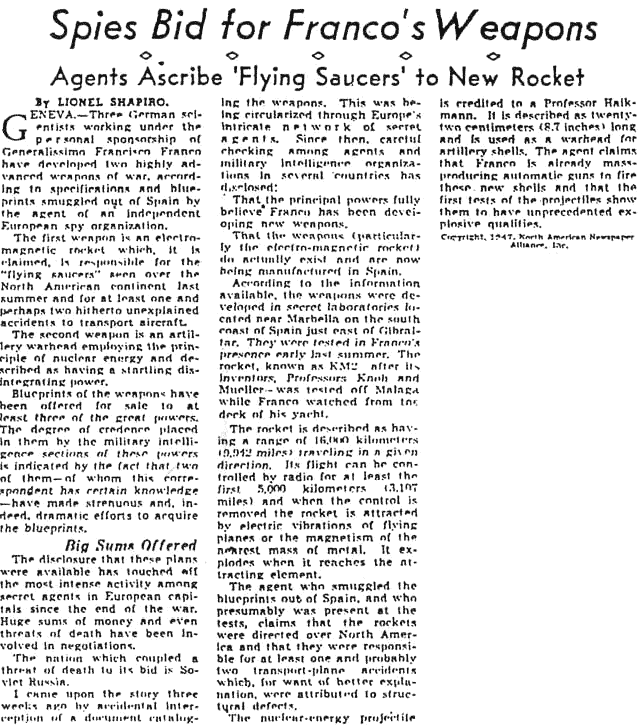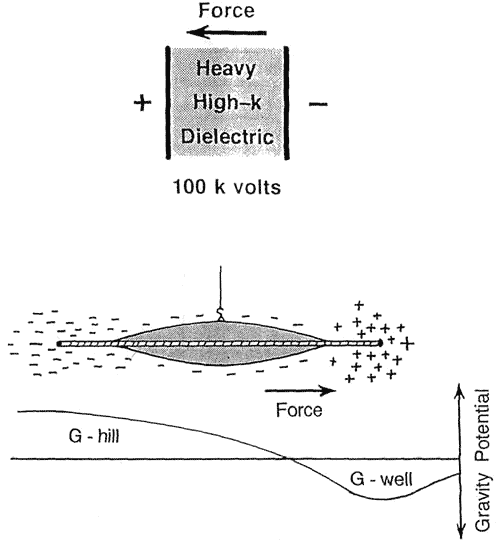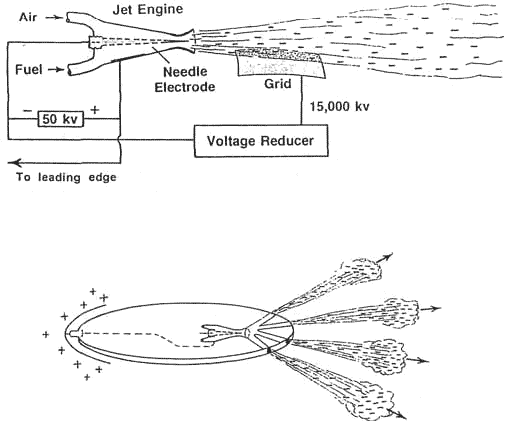The KM-2 Rocket
A shred of evidence comes down to us though the years in the form of a newspaper article by Lionel Shapiro in the Denver Post, dated November 9, 1947, and titled "Spies Bid for Franco's Weapons". (Please refer to a copy of that article). It should be noted that this was a few months after the summer of 1947, the first and largest UFO flap in history, which included the Kenneth Arnold sighting and the flying saucer activity of Roswell. It should also be noted that the Denver Post was nor is not a tabloid publication. In doing research, this newspaper was contacted in an attempt to learn the whereabouts of the author, Lionel Shapiro. Unlike so many newspapers in the United States which have been purchased and merged by conglomerates, this newspaper is still intact and in existence. Unfortunately, no record could be found of Mr.Shapiro in their personnel files although they did maintain files going back that far. Also, no record could be found in their sister publication, The Rocky Mountain News. It was suggested that Mr. Shapiro was "a stringer", that is, a writer who did not work directly for the newspaper and whose work was purchased on apiece by piece basis. His work seems to have been channeled through the North American Newspaper Alliance. More of Mr.Shapiro's history and connections will unfold as the tale progresses. This article describes two devices. The first is an "electromagnetic rocket", sometimes referred to later as the "KM- 2 rocket" in other literature. The second is a nuclear warhead small enough to be fired by an artillery piece. The nuclear,warhead which is affixed to a cannon projectile, is novel at this time and is interesting since such devices were built and fired shortly thereafter by the United States military. The article's description of the nuclear cannon is correct. This was a German invention and was under development in Germany during the latter stages of the war. A prototype was even built and it carried the German designation of DKM 44 (1). This very cannon was copied by the Americans and became the T-131 which fired a nuclear warhead (2). The discussion of the nuclear cannon is really beyond the scope of this book but what is important to bear in mind concerning this discussion is that if fifty percent of this article has proven to be accurate. The nuclear cannon was built and it stemmed from a German prototype. Does this not at least raise the possibility that the other fifty percent is accurate also? Returning to the electromagnetic rocket itself, this device is right on point for the discussion of field propulsion. Some points are ascertained in reading this article. Its description as a "rocket" would lead one to believe it was cylindrical in shape rather than saucer-shaped. It is suggested that this device was responsible for the flying saucer sightings over the USA that previous summer. This speaks for its operational range.It was said to have been tested off Malaga while Franco watched.The device was constructed in the town of Marbella, east of Gibraltar. Finally, it was said to have been of German origin,even naming the German scientists who built it. Even Spain itself is of some interest here since this country's ruler, Generalissimo Francisco Franco, was openly sympathetic to the Nazis. The Nazis had assisted Franco militarily in the Spanish Civil War during the 1930s and were instrumental in his retention of power. During the final stages of the Second World War and afterward Spain was seen, by the Germans as a safe haven for all those things they wished to keep out of Allied hands, including secret weapons. Many shipments of gold, secret blueprints, specialty steel, machine tools, scientists and high ranking Nazis were sent to Spain (3). Colonel Otto Skorzeny,head of several SS post-war, self-help organizations even set up his headquarters in Madrid (4). Spain served as a home-away- from-home for the SS after the war. In analyzing the means by which the KM-2 device flew, it must be noted that gravitational force can be overcome through the use of a strong electrostatic charge as shown by the work of T. Townsend Brown beginning in the 1920s. This is sometimes referred to as the Biefield-Brown Effect. Imagine a torpedo-shaped model with a dielectric center section suspended by a string from the ceiling. If this model were charged with high voltage, one end would become positive and the other end would become negative.Movement would occur toward the positively charged direction if the voltage was sufficient and the charged ends remained separated by the dielectric (5). This dielectric is an insulating material which can keep positive and negative charges from interacting with each other and so canceling each other out. They are commonly used in capacitors or condensers which have a positive charge on one side while retaining a negative charge on the other. If the charge can be contained by the non-conducting dielectric, a force is exerted in the direction of the positive side with the application of 75,000 to 300,000 volts. One way to conceive of this action is to imagine a gravity hill whose slope increases with the intensity of the ion charge. The craft being powered simply slides down the gravity gradient like a surfboard on a wave (6). This concept is a new, non-conventional form of flight. It is non-aerodynamic method of flight. All previous conventional flight had either been through the use of lighter than air balloons, winged craft powered by propellers, jets or rockets or the brute force of rockets themselves. Using this method, Brown advocated defeating gravity by generating another form of energy over which gravity could be surfed. It is a form of field propulsion. Electric Charge And Propulsion
T.T. Brown found that when strong electric charges are separated by a dielectric, movement occurs towards the positive charge as if gravity were reduced on the positive side or as if the charged object were sliding down a hill. T. Townsend Brown demonstrated this means of propulsion to the American military during the 1950s. He used a saucer-shaped model tethered only by a high voltage line supplying the charge to the model (7). During that decade Brown built increasingly larger, faster models using this method. Brown found that a saucer or a triangle was the best shape for this type of flying craft. A secret proposal, code-named Winterhaven, was to develop a Mach 3 anti gravity saucer interceptor was put forth to the U.S.Air Force (8). This project was further developed through the1960s but after this all traces of this concept seem to disappear. But where Brown is overlooked is not only did he have a method of electrostatic propulsion but he also had a self-contained method to impart this charge to a flying craft. He invented a flame-jet generator or electrokenetic generator which supplied the necessary high voltage in a light weight, compact manner (9). The flame-jet generator utilized a jet engine with an electrified needle mounted in the exhaust nozzle to inject negative ions in the jet's exhaust stream. A corresponding but positive charge is automatically built up upon the leading front edge of the craft.As long as there is no leakage through the dielectric or insulating material, in this case through the wings and body ofthe craft, propulsive force is generated in proportion to the strength of the charge attained. Brown estimated that such aflame-jet generator could produce potentials as high as 15 million volts of potential (10). Ionized air molecules on the leading edge of the craft's surface had other positive benefits. The positive electrical field on the wing's leading edge reduced air friction so that drag caused by air molecules was reduced. This was because individual air molecules on the wing's leading edge were repelled from each other by their like charges (11). Frictional heating was reduced. The sonic boom of such a craft was softened (12). And finally, any returning radar signal was greatly reduced (13).Dr. Paul La Violette has made the argument that all these characteristics are incorporated into the American B-2 bomber,concluding that the B-2 bomber is in reality an anti-gravity aircraft (14). As Brown repeatedly points out in his Electrokinetic Generator patent, any fluid stream can be substituted for the jet engine's fuel and air (15). This means that hot water vapor or steam itself would be suitable for this purpose. If T. Townsend Brown had been working on this form of flight since the 1920s, is it not conceivable that others were also?Remember that the KM-2 device is described as an "electromagnetic rocket". If a combination design is considered, one which combines the electrokinetic apparatus with the electrokinetic generator, a picture emerges which would seem to fulfill the description given to the KM-2 "electromagnetic rocket". The real question may be if the flow of this knowledge went from Brown to the Germans or from the Germans to Brown as was the case with so much high technology in the post-war years. T. T.Brown's early collaborator and mentor was a Dr. Paul Biefield a Professor of Physics and Astronomy at Dennison University. Dr.Biefield was a German speaker who was a fellow student of Albert Einstein in Switzerland. Physicists share information across international boundaries. There is no reason for German scientists not to have followed developments in this Biefield-Brown Effect, as it is sometimes called, for the twenty years leading up to World War Two. Before leaving the KM-2 discussion, perhaps we should return to the reporter who originally broke this story of the German"Electromagnetic Rocket" in 1947, Lionel Shapiro for a closer look at who he really was. It seems this reporter does have a history of breaking or leaking stories through the North American Newspaper Alliance. These stories which, prior to his involvement, could only be classified as "secret". The point in question is a 1946 report, brought to our attention though the extensive research of Dr. Milos Jesensky and Mr. Robert Lesniakiewicz and translated into English for me by Milos Vnenk. This account is of post-wartime intrigue can only be outlined here. On October 13, 1945, over five months after the hostilities in Europe had ended, the French embassy in Prag notified the Czechoslovakian Foreign Ministry that an SS officer in a French detention camp had given them information that a cache of secret documents existed near Prag. This cache took the form of a tunnel in which 32 boxes of secret documents were hidden and were wired with explosives before being sealed at its opening. The French offered their services and the information given to them by the SS officer in question, Guenther Achenbach. But even after three months of waiting, no response was received by the French from the Czechoslovakian Foreign Ministry (16). Somehow the Americans got wind of this information. Incredibly,the Americans on February 13, 1946 mounted an armed incursion into Czechoslovakia which was in the Soviet sphere of occupation,retrieved this hoard of information and escaped back into occupied Germany. Naturally the Czechoslovakians were furious and demanded and got an apology from the Americans. They also demanded the return of the German documents stolen from their sovereign territory. The Americans did return documents but probably not those sensitive documents for which the expedition was mounted (17). Dr. Jesensky and Mr. Lesniakiewicz have made an extensive study of the German technical facilities surrounding Prag and the purposes for these facilities. It is their conclusion that the sensitive technical information recovered and which prompted this dangerous action was nothing other than plans of the German disc airplane, the "V-7" (18). The KM-2 Rocket -- Mystery Solved
Top: T.T. Brown's flame-jet generator, capable of supplying millions of volts. Middle: Brown's saucer design which is definitely food for thought. Bottom: Brown's electric rocket incorporating flame-jet generator. The KM-2 rocket must have been a very similar device. It was Lionel Shapiro, writing under the name Lionel S. B. Shapiro who broke this story for the North American Newspaper Alliance (19). As confirmation, it can be added that the story was also covered by Ms. Lux Taub in the Swedish publication"Expressen" with stories on 2/19/46, 2/22/46 and 2/24/46 (20). In the immediate post-war world there seems to have been a relaxation on the release German technical information. Not the detailed analytic work done by the various Allied intelligence teams combing the carcass of the dead Reich, but the popular reporting by Shapiro and others who received the "o.k." to publish brief stories recounting Nazi technology which would be squelched later as the cold war got underway. But even given this relaxation, what are the chances of one reporter stumbling upon both the stories of the electromagnetic rocket and the U.S. incursion into Czechoslovakia, first, and on his own? It is also noteworthy that both of these stories dealt with the topic of this book, or at least one which is related to that theme. Mr. Shapiro must have been a very well connected reporter indeed! He is also an excellent source of information. A point of speculation should be made concerning the KM-2 device. As stated above, T. T. Brown believed that water vapor or steam was a suitable medium for his electrokenetic generator. Water vapor is present in the atmosphere, as we all know. A small atomic engine, such as was mentioned earlier in connection with the Messerschmitt P-1073, burning and being cooled by atmospheric gasses, might provide enough water vapor to enable theelectrokenetic generator to produce the high voltage required.This would be an atomic powered field propulsion device. Further, Friedrich Georg gives us details on an atomic steam engine with the Germans were designing to power a propeller driven aircraft (21). An easy substitution of a device similar to the Brown electrokenetic generator for the propellers could have been made enabling a device with all the characteristics given for the KM-2 electromagnetic rocket to have been born. And of course Dr. Giuseppe Belluzzo would have been waiting and willing to do the plumbing. The KM-2 Rocket Sources and References
Chapter IndexMain Index |



